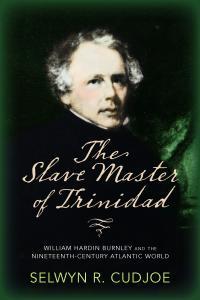Out of the cane fields of Tacarigua
By Dr Selwyn R. Cudjoe
October 24, 2022
PART IV
I began this series with the truism that the little people who come out of the cane fields and the rice paddies are the salt of the society. They are the ones who do what they must do to enhance the society because they believe they are a part of something bigger than themselves, something called community.
I started with Ulric "Buggy" Haynes, and went on to speak about Vernon Scott, William Holder, Cecil Boyce, and the other members of the Tacarigua Village Council who gave their time and energy to their community, without any financial reward.
These people invested their time in their communities because they came from a tradition in which community service was of utmost importance. This tradition went back to the 1840s when the Yorubas set up their "social league for mutual support", a kind of friendly society or village council, to take care of one another. As a result, there were hardly any poor people in the society.
Indo-Trinidadians also had their form of self-government. They activated their panchayats that adjudicated in village disputes and other social activities. JC Jha, a former professor at The University of the West Indies, noted that "in the late nineteenth century some features of rural leadership which existed in North India could be seen in Trinidad Indian villages: pundits, money lenders and landholders having a say in the important matters of the community" (Indian Heritage in Trinidad).
In 1888, Juppy, an Indian immigrant "thought the panchayat should select Indian electors in the event that the elective principle was granted with respect to the Legislative Council" (Gerard Tikasingh, "The Emerging Political Consciousness among Trinidad Indians"). By 1901, the permanent panchayat emerged as "the highest native tribunal" in the island (Port of Spain Gazette, July 23, 1899).
In June 1899 all hell broke loose when John Morton, vice-president of the Agricultural Society and the head of the Canadian Missionary Church (Presbyterians), proposed that East Indian immigrants who were being recruited as permanent settlers were not entitled to a free passage back to India. Jagmohun Singh, one of the wealthiest shopkeepers of Tacarigua, summoned a panchayat in Tunapuna to consider Morton’s motion which "had never been submitted to the consideration of Indian people whom it would affect ("Panchayat at Tunapuna", PoS Gazette)
Morton refused Singh’s invitation because it was not sent on time. Morton wrote: "As a protest against the idea that any man is to be held responsible for his actions to any self-constituted and unnamed Panchayat, I respectfully decline to attend. Had a proposal been made for a select number [of people] to meet me at my own place to talk over the matter, I should have gladly agreed to it" (Scrapbooks of John and Sarah Morton; letter dated July 21, 1899).
Although Morton attended the panchayat eventually, his position as a spokesperson for Indo-Trinidadians was broken. Thereafter, IndoTrinidadians represented their own interests, leading the Mirror newspaper to comment: "The East Indians of Trinidad form a very important part of the body politic and there is no doubt that it will not be very long before we shall find them represented in every walk in our social and political economy." (July 26, 1899.)
These self-governing bodies (the village councils and the panchayat) have always been the heartbeat of Trinidad’s grassroots democracy. However, as the society developed, the elected strata took over the democracy to serve their own interests, which is why we made a few ephemeral changes to the constitution at Independence, declaring that somehow we were practising what we call a Westminster form of government.
But even here, the "Maximum leadership government", which the Express described in Friday’s editorial, did not capture all the deformities of the system. This form of government even acts illegally. As I mentioned previously, the Tacarigua Village Council was built on land that the Orange Grove Sugar Estates gave to the Tacarigua Welfare and Improvement Council. Without blinking an eye, the central government took over the land, built a centre, decided they owned and controlled it, and demanded that villagers beg for permission to use it.
Of the 36 community councils targeted for the construction of community centres, 14 belong legally (they were donated lands) to the village councils of the area. These centres are Thick Village, Palo Seco Settlement, Quarry Village, Techier, Las Lomas #2, Guayaguayare, Diego Martin Central, Marac, Rambert, Upper Malabar, Mt Pleasant, Arima (church land) and Matelot.
From as early as January 2020, Ms Genevieve Bernard, president of the Trinidad and Tobago Association of Village and Community Councils, has complained about the government takeover of the management of these community centres and the failure of the Ministry of Sport and Community Development to engage in any form of consultation about how these centres are to be run. Their pleas have fallen on deaf ears.
If the Government acts illegally in this matter, what prevents it from acting illegally in larger matters? It is not only that maximum leadership corrupts; it deludes itself in believing that it knows what is best for every citizen, and that signals its death knell. It also betrays a system of governance that grassroots people have built up so patiently over the past 180 years and swears to the Almighty that it is working for the best interests of its citizens.
Rev William Anderson Scott said, "Whom the gods would destroy they first make mad." David Rudder puts it better: "This is not the kind of jam where you/Stand up like a chupidee begging for mercy/This is not a fete in here this is madness."
We must not be complaisant as the madness engulfs us.
Prof. Cudjoe's email address is scudjoe@wellesly.edu. He can be reached @ProfessorCudjoe.
Share your views here...

The Slave Master of Trinidad by Dr. Selwyn R. Cudjoe
|

